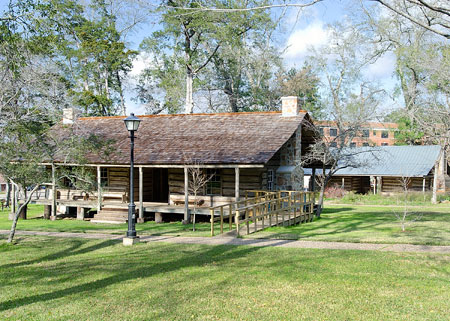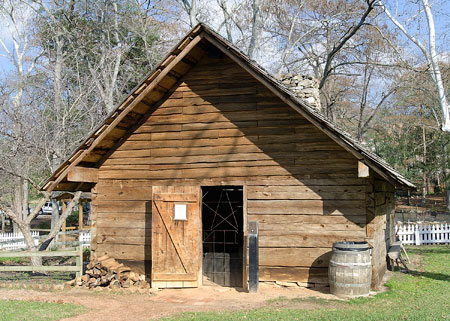Museum, Celebration Share The Houston Experience
Feb. 15, 2012
SHSU Media Contact: Meredith Mohr
 |
| The Steamboat House, on the Sam Houston Memorial Museum grounds, was built in 1858 by Rufus Bailey as a wedding present for his son. After his son refused to live there, the Houstons moved into the house in 1862. —Photos by Brian Blalock |
The inside of the rotunda at the Sam Houston Memorial Museum is cool and quiet, voices of visitors echoing off the domed ceiling, giving the museum dedicated to the life of Gen. Sam Houston a reverent atmosphere. Venture farther into the museum, and one finds it is chock full of pieces that reveal a fascinating glimpse into the general’s life.
For more than a century, the museum has served as a center for education and information about Sam Houston’s life and the role he plays in Huntsville and Texas history as a vibrant part of both the city and the university.
And every year on March 2, they honor him as part of the celebration of Houston’s birthday, which coincides with Texas Independence Day.
The museum participates in all the events, which includes the March to the Grave in honor of Gen. Sam Houston and activities planned by local historical societies.
This year’s celebration will include the grand opening of the W. S. Gibbs Conference Hall and an open house at the Katy and E. Don Walker, Sr. Education Center and in the museum from 4-6 p.m.
Other festivities include a coffee and reception at the Sam Houston Statue and Visitors Center, from 9:15-10:15 a.m.; a ceremony at the Sam Houston Grave at Oakwood Cemetery at 11 a.m.; and a “Toast to Texas” and birthday cake at the Gibbs-Powell Walker County Museum at 2 p.m.
The students at Sam Houston Normal Institute founded the museum, 15 acres of the original Houston Estate, in 1905. Under the leadership of Bertha Kirkley, they put together the homestead as a historic site. In 1911, they paid off the property, but it wasn’t until 1936 that there was the ground breaking for the rotunda museum building. In 1959 and 1962 wings were added, and throughout the years, other cabins and buildings were added. In 1995, the Katy and E. Don Walker, Sr. Education Building was opened.
Inside the rotunda museum is a collection of artifacts and manuscripts belonging to Sam Houston, and a few of his personal effects.
“My favorite thing in the museum is a green velvet hat that Sam Houston bought in the 1830s,” new museum director Mac Woodward said. “I love it because it is so unusual, but so characteristic of Houston. That hat is an example of his big personality. A lot of visitors like his jaguar vest that Sam Houston, the ultimate politician, called his 'leopard vest,' because a leopard never changes its spots.”
 |
| (Above) Museum visitors can see the inside of such historic Houston sites as the Bear Bend Cabin, where Houston would frequently hunt, and the Guerrant Cabin. Both cabins were moved to the museum grounds from their original locations and restored. (Below) The replica of Houston's kitchen is located on the museum grounds where it is believed the original was located. It was entirely hand-built without the help of any modern 20th century tools. |
 |
Other highlights are the Steamboat House, where he died, and the Woodland Home he built himself. Both feature Houston family home furniture and clothing, a working kitchen and a restored and rebuilt period kitchen and Sam Houston’s law office. The grounds also include a walking trail, a blacksmith shop and a museum shop, named Wigwam Neosho after the trading post he owned and operated.
The museum also hosts a variety of activities for visitors such as rotating Saturday demonstrations that include spinning and weaving, a presentation from the Texas Gulf Coast Cherokee Association, kick wheel pottery and blacksmithing and woodworking. They will also hold the annual Gen. Sam Houston Folk Festival, this year on April 27-28.
“The demonstrations and the folk festival are a great family experience and time to visit the museum,” Sam Houston memorial museum marketing coordinator Megan Burro said. “At the folk festival there will be folk life demonstrations, music, dance, ethnic food, cultural displays, storytelling, museum tours, arts and crafts, children activities and historical characters.”
In the 100 years of its existence, the museum, Lake Oolooteka—the pond named after Sam Houston’s adoptive Cherokee father and designed in the shape of Texas—and the grounds have served a number of purposes, for field trips, for picnics in the park, for storing hay, even as a home for the caretakers. But the most important role it has played has been as historic reminder of what Huntsville is all about, according to Woodward.
“We have a lot of artifacts and things that relate to the Houston family, as well as Sam himself,” Woodward said. “We are very interested in talking not just about Sam Houston and his history but also the historical contribution of his wife Margaret and their eight children.”
Woodward emphasized that in both of his jobs, as mayor of Huntsville and as director of the museum, he hopes that the spirit of Sam Houston and the legacy he left in the community is always remembered, whether through the Sam Houston birthday celebration or just the collection of artifacts and stories housed at the museum.
“All the historical museums in Huntsville—the Gibbs-Powell Home, the Wynne Home, the statue and visitor center, the museum—we are separate entities, but we all work together,” Woodward said. “We have different roles and focuses, but we all want to make sure the community knows why Huntsville is a great place to live and the history of this town. I have great people at the museum and at the city who are talented and dedicated, which makes it all worthwhile.”
- END -
This page maintained by SHSU's Communications Office
Associate Director: Julia May
Manager: Jennifer Gauntt
Located in the 115 Administration Building
Telephone: 936.294.1836; Fax: 936.294.1834
Please send comments, corrections, news tips to Today@Sam.edu.

 SamWeb
SamWeb My Sam
My Sam E-mail
E-mail

